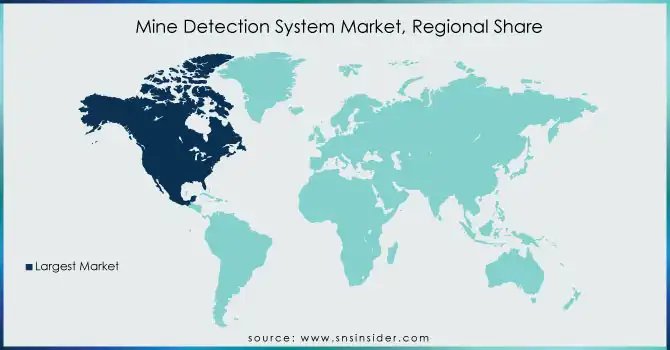Mine Detection System Market Report Scope & Overview:

To get more information on Mine Detection System Market - Request Free Sample Report
The Mine Detection System Market size was USD 5.71 billion in 2023 and is expected to reach USD 9.82 billion by 2032, growing at a CAGR of 6.3% over the forecast period of 2024-2032.
Mine Detection Systems are used in defence and homeland security. The mine detection systems equipment sector is predicted to expand at a quicker CAGR due to increased procurement of mine detection systems equipment for the upgrade of different unmanned systems due to benefits such as mine detection and counter-IEDs. The expansion of the Mine Detection Systems market is predicted to fuel the expansion of the four platforms in proportion. During the forecast period, the market is projected to be driven by the need for unmanned marine vehicles on the battlefield for surveillance and my detecting capabilities.
MARKET DYNAMICS
KEY DRIVERS
-
Rising investment in R&D
-
Rising Insecurity
-
Advanced military demands
RESTRAINTS
-
Lack of accuracy
-
Technically skilled workforce
-
Extreme amount of data
OPPORTUNITIES
-
Demand for homeland security
-
Advancing IED detection
CHALLENGES
-
High Cost
-
Complexity
-
Increasing radiations
-
High skilled labour
THE IMPACT OF COVID-19
COVID-19 is an unexpected global public health crisis that has impacted nearly every business, and the long-term impacts are expected to have an influence industry growth throughout the projection period. Our continuing study expands our research methodology to include fundamental COVID-19 concerns and relevant next steps. The research provides insights on COVID-19 by taking into account changes in consumer behaviour and demand, purchasing patterns, supply chain re-routing, the dynamics of contemporary market forces, and substantial government initiatives. The revised report contains insights, analysis, estimates, and predictions based on the COVID-19 market effect.
IMPACT OF UKRAINE & RUSSIA CRISIS
We are constantly monitoring and updating reports on the political and economic uncertainties caused by Russia's invasion of Ukraine. Negative consequences are widely anticipated across the world, particularly in Eastern Europe, the European Union, Eastern and Central Asia, and the United States. This dispute has had a significant impact on people's lives and livelihoods, as well as caused significant disruptions in trade patterns. The possible implications of the ongoing war and instability in Eastern Europe are projected to have a negative influence on the global economy, with Russia bearing the brunt of the long-term consequences
COMPETITIVE LANDSCAPE
In terms of applications, markets, and regions to assist the vendor in defining an alignment or match between their strengths and future growth potential It describes the best or most advantageous fit for vendors to pursue consecutive merger and acquisition strategies, geographic expansion, research and development, and new product introduction methods in order to execute future company expansion and growth throughout a projection time.
KEY MARKET SEGMENTATION
By Technology
-
Radar Based
-
Laser Based
-
Sonar Based
By Deployment
-
Vehicle Mounted
-
Ship Mounted
-
Airborne Mounted
-
Handheld
By Upgrade
-
OEMs
-
MROs
By Application
-
Defence
-
Homeland Security
REGIONAL ANALYSIS:
North America is expected to lead the Mine Detection Systems market during the projected period. The rising focus on increasing investments in Mine Detection Systems technologies by nations in this region is driving the growth of the North America Mine Detection Systems market. Furthermore, factors such as rising geopolitical tensions and increased defense-related spending are projected to fuel demand for Mine Detection Systems in the area. Lockheed Martin Corporation, Northrop Grumman Corporation, L3Harris Technologies, Inc., and Raytheon Technologies Corporation are all well-known and important makers of Mine Detection systems in this region.

Need any customization research on KEYWORD Market - Enquiry Now
REGIONAL COVERAGE:
North America
-
USA
-
Canada
-
Mexico
Europe
-
Germany
-
UK
-
France
-
Italy
-
Spain
-
The Netherlands
-
Rest of Europe
Asia-Pacific
-
Japan
-
South Korea
-
China
-
India
-
Australia
-
Rest of Asia-Pacific
The Middle East & Africa
-
Israel
-
UAE
-
South Africa
-
Rest of Middle East & Africa
Latin America
-
Brazil
-
Argentina
-
Rest of Latin America
KEY PLAYERS
The Key Players are BAE Systems Plc, Israel Aerospace Industries, Raytheon, Northrop Grumman Corporation, L-3 Communications Holdings Inc., Harris Corporation, General Dynamics Corporation, Schiebel Gmbh, DCD Group, Chemring Group Plc & Other Players.
| Report Attributes | Details |
| Market Size in 2023 | US$ 5.71 Billion |
| Market Size by 2032 | US$ 9.82 Billion |
| CAGR | CAGR of 6.3% From 2024 to 2032 |
| Base Year | 2023 |
| Forecast Period | 2024-2032 |
| Historical Data | 2020-2021 |
| Report Scope & Coverage | Market Size, Segments Analysis, Competitive Landscape, Regional Analysis, DROC & SWOT Analysis, Forecast Outlook |
| Key Segments | • By Application (Defence and Homeland Security) • By Deployment (Vehicle Mounted, Ship Mounted, Airborne Mounted and Handheld) • By Upgradation (OEMs and MROs) • By Technology |
| Regional Analysis/Coverage | North America (USA, Canada, Mexico), Europe (Germany, UK, France, Italy, Spain, Netherlands, Rest of Europe), Asia-Pacific (Japan, South Korea, China, India, Australia, Rest of Asia-Pacific), The Middle East & Africa (Israel, UAE, South Africa, Rest of Middle East & Africa), Latin America (Brazil, Argentina, Rest of Latin America) |
| Company Profiles | BAE Systems Plc, Israel Aerospace Industries, Raytheon, Northrop Grumman Corporation, L-3 Communications Holdings Inc., Harris Corporation, General Dynamics Corporation, Schiebel Gmbh, DCD Group, Chemring Group Plc |
| DRIVERS | • Rising investment in R&D. • Rising Insecurity. • Digital battlefields. |
| RESTRAINTS | • Lack of accuracy. • Technically skilled workforce. • Extreme amount of data. |

